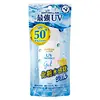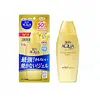What's inside
What's inside
 Key Ingredients
Key Ingredients

 Benefits
Benefits

 Concerns
Concerns

 Ingredients Side-by-side
Ingredients Side-by-side

Water
Skin ConditioningAlcohol
AntimicrobialEthylhexyl Methoxycinnamate
UV AbsorberPropylene Glycol
HumectantIsopropyl Myristate
EmollientHydrogenated Polyisobutene
EmollientEthylhexyl Triazone
UV AbsorberDiethylamino Hydroxybenzoyl Hexyl Benzoate
UV FilterStearyl Dimethicone
EmollientPhenoxyethanol
PreservativeAcrylates/C10-30 Alkyl Acrylate Crosspolymer
Emulsion StabilisingMethylparaben
PreservativePolyglyceryl-3 Methylglucose Distearate
EmulsifyingStearoyl Inulin
EmollientCarbomer
Emulsion StabilisingSodium Hydroxide
BufferingBHT
AntioxidantButylene Glycol
HumectantTocopheryl Acetate
AntioxidantEthoxydiglycol
HumectantCucumis Sativus Juice
EmollientAloe Barbadensis Leaf Juice Powder
Skin ConditioningRosa Centifolia Flower Extract
AstringentLactic Acid
BufferingGlucose
HumectantChamomilla Recutita Flower Extract
MaskingPrunus Persica Leaf Extract
EmollientLuffa Cylindrica Fruit/Leaf/Stem Extract
Skin ConditioningPerilla Ocymoides Leaf Extract
TonicTocopherol
AntioxidantBisabolol
MaskingWater, Alcohol, Ethylhexyl Methoxycinnamate, Propylene Glycol, Isopropyl Myristate, Hydrogenated Polyisobutene, Ethylhexyl Triazone, Diethylamino Hydroxybenzoyl Hexyl Benzoate, Stearyl Dimethicone, Phenoxyethanol, Acrylates/C10-30 Alkyl Acrylate Crosspolymer, Methylparaben, Polyglyceryl-3 Methylglucose Distearate, Stearoyl Inulin, Carbomer, Sodium Hydroxide, BHT, Butylene Glycol, Tocopheryl Acetate, Ethoxydiglycol, Cucumis Sativus Juice, Aloe Barbadensis Leaf Juice Powder, Rosa Centifolia Flower Extract, Lactic Acid, Glucose, Chamomilla Recutita Flower Extract, Prunus Persica Leaf Extract, Luffa Cylindrica Fruit/Leaf/Stem Extract, Perilla Ocymoides Leaf Extract, Tocopherol, Bisabolol
Water
Skin ConditioningAlcohol Denat.
AntimicrobialEthylhexyl Methoxycinnamate
UV AbsorberButylene Glycol
HumectantDiphenylsiloxy Phenyl Trimethicone
Skin ConditioningDiethylamino Hydroxybenzoyl Hexyl Benzoate
UV FilterBis-PEG-18 Methyl Ether Dimethyl Silane
EmollientSodium Hyaluronate
HumectantSodium Acetylated Hyaluronate
HumectantHydrolyzed Collagen
EmollientArginine
MaskingBis-Ethylhexyloxyphenol Methoxyphenyl Triazine
Skin ConditioningGlycol Dimethacrylate Crosspolymer
Polyvinyl Alcohol
Acrylates/C10-30 Alkyl Acrylate Crosspolymer
Emulsion StabilisingPEG-12 Dimethicone
Skin ConditioningDisodium EDTA
Xanthan Gum
EmulsifyingMelaleuca Alternifolia Leaf Oil
AntioxidantPolystyrene
Polyglyceryl-10 Pentaisostearate
EmollientMethylparaben
PreservativeWater, Alcohol Denat., Ethylhexyl Methoxycinnamate, Butylene Glycol, Diphenylsiloxy Phenyl Trimethicone, Diethylamino Hydroxybenzoyl Hexyl Benzoate, Bis-PEG-18 Methyl Ether Dimethyl Silane, Sodium Hyaluronate, Sodium Acetylated Hyaluronate, Hydrolyzed Collagen, Arginine, Bis-Ethylhexyloxyphenol Methoxyphenyl Triazine, Glycol Dimethacrylate Crosspolymer, Polyvinyl Alcohol, Acrylates/C10-30 Alkyl Acrylate Crosspolymer, PEG-12 Dimethicone, Disodium EDTA, Xanthan Gum, Melaleuca Alternifolia Leaf Oil, Polystyrene, Polyglyceryl-10 Pentaisostearate, Methylparaben
 Reviews
Reviews

Ingredients Explained
These ingredients are found in both products.
Ingredients higher up in an ingredient list are typically present in a larger amount.
Acrylates/C10-30 Alkyl Acrylate Crosspolymer is a synthetic polymer. It is used to thicken and improve the texture of products. Due to its properties, it can prevent water and oil ingredients from separating.
Butylene Glycol (or BG) is used within cosmetic products for a few different reasons:
Overall, Butylene Glycol is a safe and well-rounded ingredient that works well with other ingredients.
Though this ingredient works well with most skin types, some people with sensitive skin may experience a reaction such as allergic rashes, closed comedones, or itchiness.
Learn more about Butylene GlycolDiethylamino Hydroxybenzoyl Hexyl Benzoate (DHHB) is a chemical UV-A absorber. It is formulated for high UVA protection (320-400 nm).
DHHB is well-liked for:
DHHB has been approved by the EU, Japan, Taiwan, and South America for use up to 10%. Unfortunately, it has not been approved for use in the US or Canada due to slow regulatory processes.
This ingredient is soluble in oils, fats, and lipids.
Learn more about Diethylamino Hydroxybenzoyl Hexyl BenzoateEthylhexyl Methoxycinnamate is an organic compound that provides UVB protection. It often goes by the more common name of octinoxate. It is created from methoxycinnamic acid and 2-ethylhexanol.
Ethylhexyl Methoxycinnamate absorbs UVB rays with wavelengths between 280-320 nm. UV absorbers protect your skin by using chemical reactions to convert UV rays into heat and energy.
UVB (290-320 nm) rays emit more energy than UVA rays. They are capable of damaging DNA, causing sunburns and are thought to be linked to skin cancer.
The state of Hawaii has banned sunscreens containing octinoxate due to its potential impact on coral reefs. More research is needed to bridge gaps in this research. The European Union allows higher levels of octinoxate in sunscreens than the US and Australia.
Ethylhexyl Methoxycinnamate is oil soluble. It is not stable and may lose efficacy when exposed to sunlight.
Learn more about Ethylhexyl MethoxycinnamateMethylparaben is a preservative and is a paraben. It is used to prevent the growth of fungus, mold, and other harmful bacteria. Parabens are chemicals used as preservatives in both cosmetics and food.
Methylparaben can be synthetically created. It can also be found naturally in some fruits, such as blueberries.
Oftentimes, Methylparaben is combined with other parabens to help increase the shelf life.
The safety of Methylparaben is currently being studied. While ongoing studies are looking into the safety of parabens, the results have been very mixed. Some studies have not found Methylparaben to be harmful.
Learn more about MethylparabenWater. It's the most common cosmetic ingredient of all. You'll usually see it at the top of ingredient lists, meaning that it makes up the largest part of the product.
So why is it so popular? Water most often acts as a solvent - this means that it helps dissolve other ingredients into the formulation.
You'll also recognize water as that liquid we all need to stay alive. If you see this, drink a glass of water. Stay hydrated!
Learn more about Water